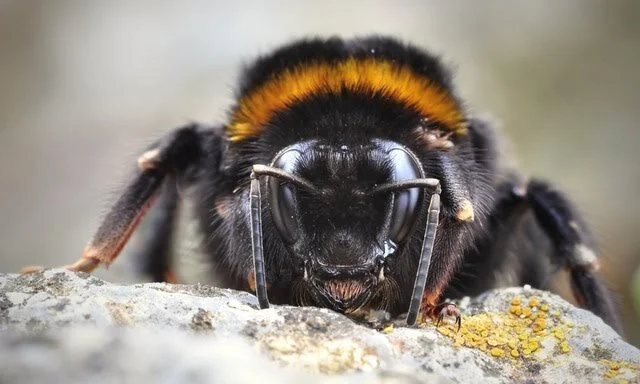Pests Part III: Buzzers and Crawlers
There are many little pests that can be a nuisance to homeowners. To protect your home from damage, it is important to learn about their habits so that elimination can occur stress free.
Carpenter Bees
Unlike the more widely known bumblebees who nest underground, carpenter bees construct their nests in trees or buildings. While a single carpenter bee’s drilling activity is mild, the exponentially growing broods each year will expand the tunnels through branching activities, potentially causing severe structural damage. The bees do not eat the wood, but rather excavate the tunnels for shelter and as chambers in which to raise their young. Common targets include unpainted woods such as doors, window sills, roof eaves, shingles, railings, telephone poles, and even wooden lawn furniture. Look for perfectly round entrance holes typically ½ inch in diameter and located against the grain of the wood.
Luckily, there are things homeowners can do to eliminate carpenter bees.
Locate the wood where the bees seem to be the most active.
Using a flashlight covered in red cellophane (the bees cannot see red light), highlight all the openings to the tunnels.
Since you’ll be using chemical treatment, it is recommended to wear protective clothing, gloves, goggles, and a respirator or dust mask since the insecticidal dust may become airborne during the spraying process.
Apply an insecticidal dust directly into the nest openings using a duster that not only blows dust into the tunnel but also coats the sides.
Do not plug the holes immediately following treatment. The bees should be able to pass through the holes; their bodies will catch the dust and spread it throughout the tunnels.
Following the application of any insecticidal treatment, launder clothes worn separate from other laundry and shower to remove any dust that remains on the body.
Treatment is best done in Spring when bees first appear for the warm weather and then again mid way through Summer. Final treatments can be done in early fall to make sure any remaining bees occupying the tunnels are reached. After final treatments are applied, holes should be plugged with a wood putty or wooden dowels and then the entire wood surface painted or varnished.
Wasps, Hornets, and Yellow Jackets
Regularly inspecting your home to find wasp, hornet, or yellow jacket nests is key to helping prevent large numbers of the buzzing variety flying around your yard or even inside your home. Common nest locations are typically in shaded areas and might include under roof awnings, behind shutters, hanging from tree branches, fence posts, play sets, hollow tree trunks, stacked wood, lawn or mulched areas. Similar to carpenter bees, look for small holes around the diameter of a pencil. This is best done in the day when the insects are most active.
Products like Raid specialize in specific sprays for killing this type of insect. When treating for wasps, hornets, or yellow jackets, there are certain things that are important to keep in mind.
Treatments are best applied at dusk or dawn when the insects will be less active.
Gloves and long sleeves should be worn to prevent stings.
When spraying, spray with the wind rather than against it. In addition, make sure to stand away from the nest and not directly underneath if it is raised.
If you are allergic to stings, have someone else do the treatment on your behalf. It is not worth getting stung. If you are stung at all and experience any severe symptoms, seek medical attention immediately.
To keep the wasps, hornets, and yellow jackets out of your home, make sure all door and window cracks are sealed and inspect window screens to make sure there aren’t any holes. They are attracted to sugary foods, so keep garbage containers sealed and away from entrances. In addition, it can be helpful to rinse recyclable materials before putting them in the bin.
Ants
Ants in the home can be present seasonally or year round. If the ants find a good food source in the home, they may continue to leave their outdoor nests, venture inside to collect their food, and return to the colony with their stores. Some ant species will even build their nest indoors to begin with. Either way, ants can be difficult to control. Knowing what type of ants you’re dealing with is important in management and elimination of the problem. Many ants have different behaviors and characteristics; they are not the same so they require different approaches.
There are ways to prevent or deter ants from coming into your home in the first place:
Remove or minimize moisture; ants need water to survive. This may involve fixing water leaks around pipes or the roof. Also it may be wise to make sure gutters and downspouts direct rain away from the house.
Keep things clean! Clean up after eating or cooking; keep tables, cabinets, counters, and floors tidy. Dirty dishes should not be left in the sink overnight, and appliances should be cleaned regularly.
Ants can make their way inside through holes, gaps, or cracks, so seal locations where wires, conduit, or pipes enter the house. Tree limbs could serve as bridges from the outdoors to the house, so keep trees pruned so they’re not touching the structure.
Keep firewood stored away from the house as well as any rock piles or extraneous debris; this can serve as shelter for the ants to make their colony.
Despite seeming useless to most, ants are actually very important to the ecosystem. There are plenty of natural remedies for encouraging ants to go back to whence they came.
Vinegar: Ants leave scent trails for other ants in their colony to follow and find food previously discovered by a scout ant. Every time a new ant travels the path previously made, the smell intensifies for new ants. White vinegar applied to all entrances or known access paths will disrupt the scent trails making it harder for the ants to find where they’ve previously found any food sources.
Chalk: Ants will not cross chalk lines; it has been suggested that minerals in the chalk, such as talc, kill the ants. As such, ants will steer clear of chalk. Drawing a simple line or two to block access points or entrances will deter the ants from being able to use that location.
Honey Training: Ants aren’t looking for a battle or to fight to find their way into your home; they’re just interested in food. It may be more prudent to attempt to divert the ants rather than eliminate them. Once the scent trails are eliminated and deterrents applied to entrance points, mix a couple tablespoons of honey with water on a paper plate. Leave the plate outside a little ways away from the house but not too far so that the ants will not be able to find it. The ants will happily snack on the honey mixture, and once they discover it you can move it farther and farther away from the house, refilling as needed.
Essential Oils: Ants don’t like intense smells as they upset lines of communication and scent trails. Essential oil sprays, a mix of 20 drops of peppermint or eucalyptus essential oil with water, can deter ants when sprayed anywhere the ants enter or walk. In addition, a cotton ball soaked in essential oil use to wipe down a surface or plug an entrance hole can be equally effective.
In the event that none of the aforementioned ideas work effectively to eliminate the ant problem, your only choice may be to kill the colony. Fill a medium pot with water, leaving enough room at the top that you can carry it without it sloshing over. Bring to a boil, and then stir in a biodegradable dish soap. Put a lid on the pot and using hand mitts, carry it outside and pour onto the nest. Maintain a steady speed as to not overflow the nest’s entrance so that the water can make it’s way down into the various tunnels.
Cockroaches
Roaches may make you squeamish because many people believe that they come into the home due to mess or filth. While that might extend the length of their stay in your house, roaches merely are searching for water, food, and warm shelter. Their population continues to grow because they need so little to survive. They might get into the home by catching a ride on a grocery bag or crawling through tiny gaps around doors or other open spaces.
Similar to ants, it is important to know where the roaches are coming from or where they’ve set up camp in your home. If you’ve noticed them more so in one area over another, such as the kitchen, odds are they are residing somewhere in that room. Sticky traps, made to catch the roaches in their tracks, can be effective for catching some of the pests. While you wait for the sticky traps to work, certain items that roaches are attracted to are best removed from the home: piled newspaper, cardboard boxes, paper bags, and piles of clutter. Roaches are especially drawn to paper products because it can aid in their communication with other roaches; the paper absorbs the roaches’ GPS-like pheromone, serving as a beacon for the trail they leave.
In addition to eliminating paper products, a thorough cleaning of the house, especially the kitchen, is necessary. Also clean any places where there is standing water, such as drip plates for plants or leaks.
Once attention drawing items are removed, sprinkle some boric acid or roach baits on cracks where the roaches are entering through; they work to lure the bugs and kill them. Do not use either of these in food preparation areas, near children, or pets. If this does not work, then you may consider using a pesticide. Most take a week to produce results, so don’t lose heart.
Of course, as with any pest, if you find home remedies are not curbing the problem in your home, it may be best to contact a professional!
Dwell360 is a residential real estate firm based in Newton, Massachusetts, servicing the cities and suburbs of Greater Boston. We are focused on our customers and seek to educate about household pests. Search for homes in Massachusetts and then give us a call.
Sources:
Jacobs, Steve. (January 2014). Carpenter Bees. Retrieved from http://goo.gl/uwTd9d.
Raid. How Do I Get Rid of Wasps/Hornets/Yellow Jackets?. Retrieved from http://goo.gl/E2XiLf.
Orkin. Ants in Your House. Retrieved from http://goo.gl/7mGk1l.
Goodall, Claire. 5 Ways to Get Rid of Ants Naturally Without Killing Them. Retrieved from http://goo.gl/GUwbjU.
Conger, Cristen. (July 15, 2008). How do roaches get into homes? Retrieved from http://goo.gl/OL0x2n.
Images licensed under Creative Commons Zero on Pexels.com
Images licensed under Creative Commons Zero on Pixabay.com





